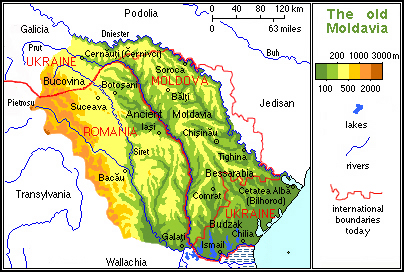Moldavian Plateau
This article has multiple issues. Please help improve it or discuss these issues on the talk page. (Learn how and when to remove these template messages)
|
| Moldavian Plateau | |
| Topography | |
|
Bukovinian Subcarpathians Suceava Plateau | |
| Hydrography | |
|
Suceava )Prut Dniester (Răut) Black Sea |
|
| Climate | |
| Flora & Fauna | |
|
Flora of Romania List of mammals in Romania List of mammals in Moldova Protected areas in Romania Protected areas in Moldova |
The Moldavian Plateau (Romanian: Podișul Moldovei) is a geographic area of the historical region of Moldavia, spanning nowadays the east and northeast of Romania, most of Moldova (except the south), and most of the Chernivtsi Oblast of Ukraine (where it is known as the Pokuttyan-Bessarabian Upland[1]).
Limits

The Moldavian Plateau is bounded (in clockwise order), as follows.
- To the west by the Eastern Carpathian Mountains (Romanian: Carpații Orientali).
- To north and north-east by the Podolian Plateau (Romanian: Podișul Podoliei).
- To the east and south east by Bugeac Plain (Romanian: Câmpia Bugeacului, Câmpia Moldovei de sud), comprising 3,210 km2 (1,240 sq mi) in Moldova.
- To the south by the Romanian Plain (also known as the Wallachian Plain) and the Bărăgan Plain (Romanian: Câmpia Română, Câmpia Bărăganului).
- To the southwest by the Vrancea Hills (Romanian: Dealurile Vrancei), part of the Sub Carpathians (also known as the Curvature Carpathians) (Romanian: Subcarpații de curbură).
The Moldavian Plateau comprises over two-thirds of the territory of the medieval
Genesis
The Moldavian Plateau was formed at the end of the
The slope of the terrain follows the direction of the rivers: from northwest to southeast. Along them, the altitude decreases from 700 m (2,300 ft) to under 200 m (660 ft). The strata are disposed in North-South and northwest-southeast aligned layers, producing asymmetric valleys and ridges. Among the latter are the steep edge of the Bârlad Plateau (Romanian: Podișului Bârladului), known as the Iași Ridge (Romanian: Coasta Iașilor), the edge of the Central Moldavian Plateau (Romanian: Podișul Moldovei Centrale), known as the Cornești Hills, and the edge of the Dniester Hills, known as the Dniester Ridge.
The relief in the valleys of the rivers and creeks is quite conspicuous, so that the valleys have large
Composition
The Moldavian Plateau comprises several distinct regions:
- The Bukovinian Subcarpathians in the northwest.
- The Moldavian Subcarpathians in the west and southwest, has altitudes of up to 1,000 m (3,300 ft), but also includes depressions.
- The Suceava Plateau (Romanian: Podișul Sucevei), situated in the northwest, has altitudes that exceed 700 m (2,300 ft) and long ridges.
- The Dniester Riverand has elevations of approximately 300 m (980 ft).
- The Moldavian Plain (Romanian: Câmpia Moldovei), in the center-north has elevations of approximately 200 m (660 ft):
- The Jijia Plain, west of the river Prut.
- The Middle Prut Valley, east of the river Prut, creeks tributary to the Prut, 2,930 square kilometres (1,131 sq mi).
- The Bălți Steppe, east of the river Prut, creeks tributary to the Dniester, 1,920 square kilometres (741 sq mi).
- The Bârlad Plateau (Romanian: Podișul Bârladului), situated in the south-center occasionally has heights over 500 m (1,600 ft), but is generally sloped from north at 400 m (1,300 ft) to the south at 200 m (660 ft).
- The Central Moldavian Plateau (Romanian: Podișul Moldovei Centrale), situated in the center and southeast, has elevations that in the north-south direction decrease in altitude from 400 m (1,300 ft) to under 200 m (660 ft).
- The Bugeac Plain, the last continuation of the Pontic–Caspian steppe.
Climate
The climate of this plateau is transitional
The main influence on the climate is Dry Continental with frequent cold north winds in winter. In the Suceava Plateau and the Dniester Hills, there is an influence of Scandinavo-Baltic climate with the circulation of masses of polar air in the winter.
Waters
Streams on the plateau flow into the Siret, Prut, or Dneister rivers. The Prut has the Jijia as its principal tributary. The Siret traverses and—with the exception of the Subcarpathians—limits the Moldavian Plateau
The lack of precipitation has required water management in the Jijia Plain and in the Bălți steppe which serves as a reservoir and for
Natural resources
The Moldavian Plateau holds
Hemp is cultivated in the Suceava plateau, cereals and wine grapes (Vitis vinifera) in the Jijia Plain, Bălți steppe, Bârlad Plateau and Central Moldavian Plateau. In the Siret Passage they cultivate potatoes and sugar beets.
Fauna
Characteristic of the plateau are mammals such as goats, wild
.References
- ^ Bessarabia Archived August 14, 2015, at the Wayback Machine at Encyclopedia of Ukraine.
- ISSN 2391-5447.
External links
- "Podișul Moldovei". www.ebacalaureat.ro (in Romanian). Retrieved December 25, 2022.
